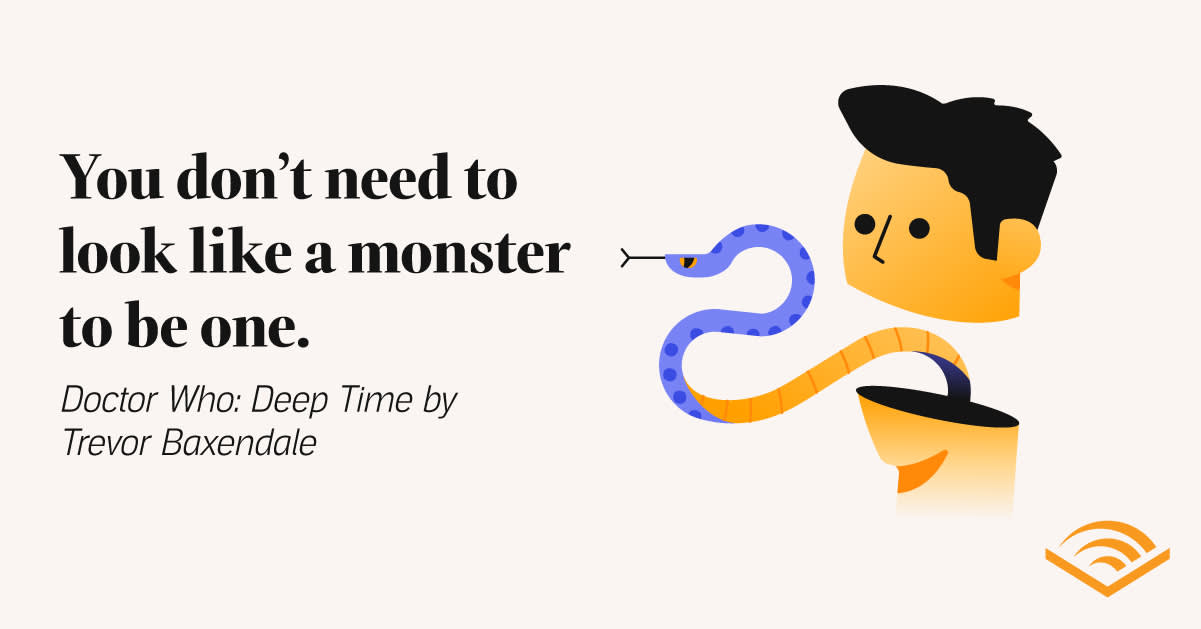I was curious about Doctor Who for over a decade before I finally decided to dive in. Up until then, fandom felt daunting. It's challenging to know where to start a series built on more than 60 years of history, countless spin-offs and adaptations, and a massive amount of lore. Did I need to go back to the 1963 television premiere to understand the show? What's it about? And what the heck is a TARDIS?
Yes, Doctor Who comes with a whole lot of history—but it’s well worth getting up to speed. I chose to start with the 2005 reboot of the series and worked my way into the Whoniverse from there, but no matter where you jump in, there's really no wrong place to begin. Read this explainer of the world of Doctor Who to give you a basic understanding of everything you need to know and then bravely venture into the galaxy—whether your first adventure is housed in the audiobooks, television series, movies, radio dramas, or beyond.
What is Doctor Who about?
Doctor Who is a long-running British science fiction series following the Doctor, an alien humanoid Time Lord who travels through space and time to fight evil, protect the innocent, and stop history from being catastrophically altered. The Doctor, who "regenerates" into a new body when seriously injured, has been played by many different actors across the history of the show. They travel the universe, usually with a human companion, in a spaceship called the TARDIS that appears as a blue British police box to outside observers.
Doctor Who was designed as a show for the whole family that combines action, adventure, space travel, and comedy. It is typically made up of self-contained episodes that can be enjoyed out of context, set in different times and locations, spanning historical events on Earth to the distant future in other galaxies. Many seasons also contain serialized multi-episode story arcs. Frequently exciting, often adventurous, and always alive with humor and heart, Doctor Who is a television long-stay for good reason.
So, who is the Doctor? And what is a “companion”?
The Doctor is a Time Lord, a humanoid alien who can travel through time in a nonlinear fashion. Time Lords tend to live very long lives, often for centuries, and can regenerate into new bodies when they're seriously injured. They can, however, be killed, and so, we meet the Doctor after a massive war with the Dalek when they believe themself to be the only remaining Time Lord.
With each regeneration, we meet a slightly different version of the Doctor with a varying balance of eccentricity, curiosity, irritability, and compassion, all of which fit into the larger arc of the Doctor's lifetime. They travel by TARDIS and use a Sonic Screwdriver, a futuristic multipurpose tool, to solve a wide variety of problems. The Doctor takes a special interest in Earth and humanity.
That leads us to the role of the companion, which I must admit was also my biggest source of confusion when I first started Doctor Who. The Doctor's companions are usually (although not always) human, and often (although not always) young women. I quickly noticed a certain romantic tension between the Doctor and their companions, one that usually came with inner turmoil for the Doctor. Are companions meant to be love interests for the Doctor? Not really. In fact, in the 1963 to 1989 run of the series, writers prohibited romantic storylines between the Doctor and their companions, shooting instead for a more parental relationship. From a storytelling perspective, companions are a stand-in for the audience, characters who are as amazed and surprised as the folks watching at home. They also add a certain element of danger and risk, becoming someone the Doctor frequently has to save.
So, what purpose does a companion serve for the Doctor? In most cases, they fall somewhere between "friend" and "assistant," providing color commentary and occasionally proving helpful in their own right, as they are teachers, scientists, journalists, and more. Mostly, the role of the companion is to entertain the Doctor and serve as a kind of moral compass, reminding the Doctor of humanity's complexity and why the universe is worth saving.
Where is the Doctor from?
The Doctor was born on the planet Gallifrey, the home of the Time Lords, 250 million light-years from Earth. The Time Wars, conflicts between the Time Lords and the Daleks, led to widespread violence on Gallifrey. We learn throughout the series that the Doctor stole a TARDIS to escape the war and believed at the time of his departure that Gallifrey was destroyed and all other Time Lords killed. The Doctor is typically presented as the last of his race, without a home planet, set adrift in space and time.
What is the TARDIS?
TARDIS is an acronym for "Time And Relative Dimension In Space." The TARDIS is a spaceship and time travel device used by the Doctor for their travels. While TARDISes typically have a means of disguise that makes them appear like nearby objects wherever they land, the Doctor's TARDIS is permanently stuck with an exterior that looks like a blue British police box. The TARDIS is famously "bigger on the inside," as it appears relatively small from the outside but has a vastly larger interior with a massive navigation console and multiple rooms. It travels by materializing and dematerializing into time vortexes.
What is a regeneration?
When suffering severe bodily harm, the Doctor can regenerate into a new, unharmed body with a different appearance and personality. This process was first invented for the show when William Hartnell, the original actor to play the Doctor, experienced health problems after three seasons and needed to step down. It's a helpful tool for casting, but regeneration is also effectively used as a narrative tool in the Doctor's journey. The Doctor has little to no control over when they regenerate, or their new appearance, and regeneration usually includes some physiological and psychological unsteadiness. (Oh, and fun fact—the portrayal of the regeneration process was originally modeled after a bad LSD trip!)
When did Doctor Who first premiere? What is the history of the show?
Doctor Who first premiered on the BBC on November 23, 1963. Notably, its debut was the day after the assassination of John F. Kennedy. The broadcast was delayed by eighty seconds, and the first episode was played again a week later before the second episode aired for those who missed it due to the breaking international news.
The series ran most consistently between 1963 and 1989, with seven different actors playing the role of the Doctor, before viewership declined following a change in writers, performers, and airtime. In 2005, Doctor Who was rebooted after a 16-year hiatus. This newer version of the series continues today with Ncuti Gatwa playing the 15th regeneration of the Doctor. Doctor Who is the longest-running sci-fi show on television and has the highest viewership numbers, with syndication across the globe. It has been adapted into films, spin-off series, books, stage plays, radio shows, video games, and more.
What actors have played the Doctor in Doctor Who?
14 different actors have played the lead character of the Doctor across the series' long history. They include:
William Hartnell (1963-1966)
Patrick Troughton (1966-1969)
Jon Pertwee (1970-1974)
Tom Baker (1974-1981)
Peter Davison (1982-1984)
Colin Baker (1984-1986)
Sylvester McCoy (1987-1989)
Paul McGann (1996)
Christopher Eccleston (2005)
David Tennant (2005-2010, 2023)
Matt Smith (2010-2013)
Peter Capaldi (2014-2017)
Jodie Whittaker (2018-2022)
Ncuti Gatwa (2023-present)
Other actors have played different regenerations of the Doctor in various episodes and specials. Tom Baker played the Doctor for the longest stretch of the show, appearing in 172 episodes, and Paul McGann played the Doctor the least, appearing in only one 1996 TV movie and one special episode in 2013. Jodie Whittaker became the first woman to play the role of the Doctor in 2018, and Ncuti Gatwa became the first Black actor to play the Doctor in 2023.
Who are the Doctor’s most memorable villains?
The Doctor faces many unique villains across the series. Some of their most memorable foes return in different plots across the series.
The Daleks are the Doctor's greatest enemy, as they destroyed the Doctor's home planet and sought to eliminate all Time Lords. They are cyborg aliens housed in metal cone-shaped armor with a domed top featuring one mechanical eye, one plunger-esque arm, and one whisk-esque arm/weapon. The Dalek are violent, unfeeling, and genocidal, frequently focused on ending various alien races. The writers of the original 1960s series modeled the Daleks after the Nazi regime.
Cybermen are another frequent foe of the Doctor. Similarly to Daleks, Cybermen are cold, violent cyborgs. They are humans or humanoids that have been forcefully converted into cybermen in steel robotic bodies, retaining little of their natural body and personality. Cybermen travel through space to take hostages and convert them to their ranks.
The Master is a recurring villain character that has appeared in the series from 1971 through the present. Also a Time Lord, the Master was the Doctor's childhood friend, but as the Doctor chose to fight evil and protect the universe, the Master sought to control the universe. Like the Doctor, the Master is capable of regeneration and has been played by nine different actors over the course of the series. Their personal history—and the fact that they are two of the only living Time Lords—makes for a complicated relationship between the Doctor and the Master.
Weeping Angels are some of the most iconic villains across the Doctor Who series. Initially appearing as angelic stone statues, Weeping Angels are an alien species that move quickly and silently closer to their prey whenever they aren't being actively watched, even in the time it takes to blink. The closer they get, the more demonic their form becomes, with sharp teeth and pointy claws. Weeping Angels are frequently ranked among the scariest villains on Doctor Who, as well as across all TV series.
Who are the Doctor’s most memorable companions?
While there have been many iterations of the Doctor, there have been even more companions, with more than 60 different actors playing companion roles in the Doctor Who television series. Here are some of the most memorable companions:
Sarah Jane Smith (played by Elisabeth Sladen) is one of the most popular and prolific companions. She co-starred in 80 episodes, primarily with Doctors three and four from 1973 to 1976. She also appeared in multiple specials and the 2005 reboot of the show. Sarah Jane is an investigative journalist who meets the Doctor while working on a story about a secretive research facility.
Amy Pond (played by Karen Gillan) and Rory Williams (played by Arthur Darvill) are one of several couples to serve as companions, featured alongside the eleventh Doctor from 2010 to 2012. The Doctor crashes into Amy's front yard when she's only seven years old and returns again twelve years later. Rory, Amy's fiancé, expresses concerns that Amy is in love with the Doctor, but Rory is ultimately invited to travel aboard the TARDIS with them. Together, they have a child, who (no spoilers here!) also winds up being a fan-favorite character.
Donna Noble (played by Catherine Tate) brings some of the best comic relief to the series in her travels alongside the 10th and 14th Doctors, primarily from 2008 to 2010. First appearing as a bride who unexpectedly appears aboard the TARDIS, temp office worker Donna is initially angry to be interrupted, but quickly finds the Doctor's intergalactic travels far more interesting than her normal life.
Martha Jones (played by Freema Agyeman), a medical student and the series' first Black companion, is one of the more powerful and impactful characters to ride the TARDIS and save the universe. Martha is smart, capable, and craves adventure in her travels with the 10th Doctor from 2007 to 2008. She also appears in the spin-off series Torchwood.
New listens for Doctor Who fans
Looking for more ways to dive into the Whoniverse? Check out these fresh and forthcoming audiobooks.
If you think the Doctor has seen some things, imagine what the TARDIS has been through. In this action-packed, perspective-shifting audiobook, we'll hear the TARDIS's side of the story, from her escape from Gallifrey with the first Doctor through today's adventures with the 15th Doctor. It's narrated by Lizzie Hopley, who has been a writer, actor, and voice actor on various Doctor Who episodes and spin-offs.
This thrilling installment finds the Doctor and his companion Ruby in the middle of an ancient rivalry between the worlds Yewa and Bia. The beautiful Gardens of Kubuntu in Yewa may seem perfectly peaceful, but something sinister is lurking in the shadows, stoking a potential war. Can the Doctor and Ruby find answers in the planet's hidden history?
This collection combines four of the highest-stakes novelizations of Doctor Who episodes, including stories from the first, fourth, 10th, and 11th Doctors. Join the Doctor as they seek to save planets from total destruction before it's too late. With stories narrated by Maureen O'Brien, Peter Purves, John Leeson, and Nicholas Briggs, all acclaimed actors who have played roles on Doctor Who, it's a nostalgic audiobook into the Doctor's past adventures.
Susie Dumond is the author of Queerly Beloved and Looking for a Sign. She is a Senior Contributor at Book Riot and a bookseller at Loyalty Bookstore in Washington, D.C.







